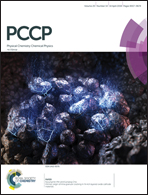Time dependence of NMR observables reveals salient differences in the accumulation of early aggregated species between human islet amyloid polypeptide and amyloid-β†
Abstract
Type 2 diabetes mellitus and Alzheimer's disease are characterized by the accumulation of fibrillar amyloid deposits consisting mainly of islet amyloid polypeptide (IAPP) and amyloid-β (Aβ), respectively. Fibril formation is a multi-step nucleation process that involves the transient build-up of oligomeric species that are thought to be the most toxic components. To gain more insight into the molecular mechanism of early IAPP aggregated species formation, we performed a combination of direct and indirect biophysical approaches on IAPP and also on Aβ42 for the sake of comparison. Thioflavin T fluorescence kinetics measurements revealed a stronger autocatalytic behaviour of IAPP and a weaker concentration dependence of fibrillization half-time t1/2, as compared to Aβ42. Our NMR experiments highlight the absence of micelle reservoir or supercritical regime in the studied concentration range, indicating that the low concentration dependence of IAPP fibril formation can be ascribed to saturable pathways. IAPP and Aβ42 displayed marked differences in formation of oligomeric species, as observed by 1D 1H, pulsed-field gradient (PFG) diffusion and saturation transfer difference (STD) NMR experiments. A fast equilibrium between monomer and oligomeric species was detected in the case of Aβ42 but not IAPP, with a significant build-up of aggregated species, as shown by the time dependence of diffusion coefficient and STD magnetization transfer efficiency during the aggregation process. Altogether our data show significant differences between IAPP and Aβ42 regarding the microscopic events of amyloid species formation.



 Please wait while we load your content...
Please wait while we load your content...